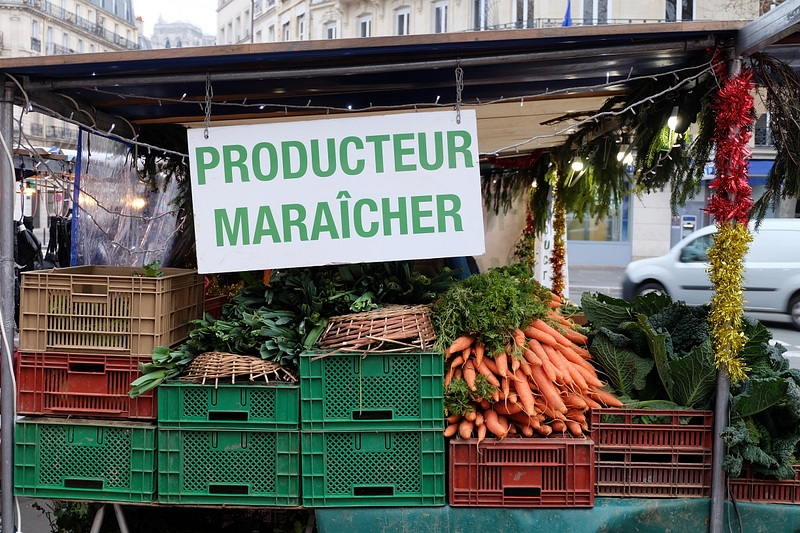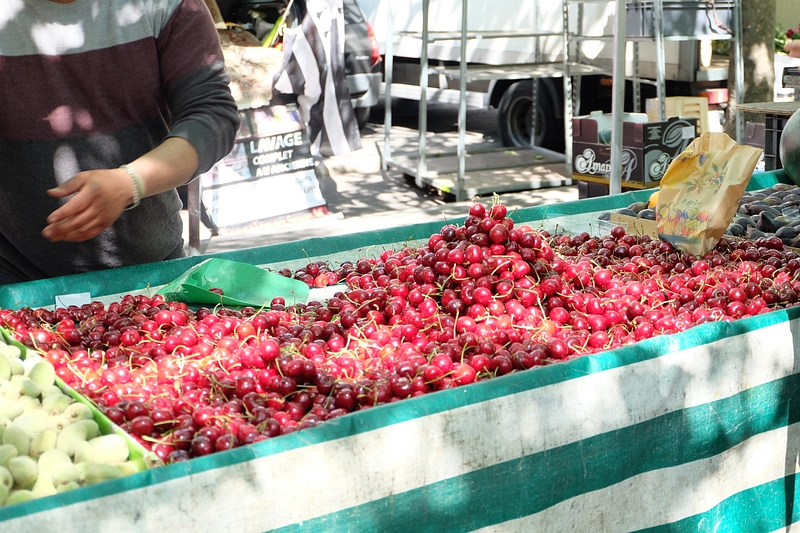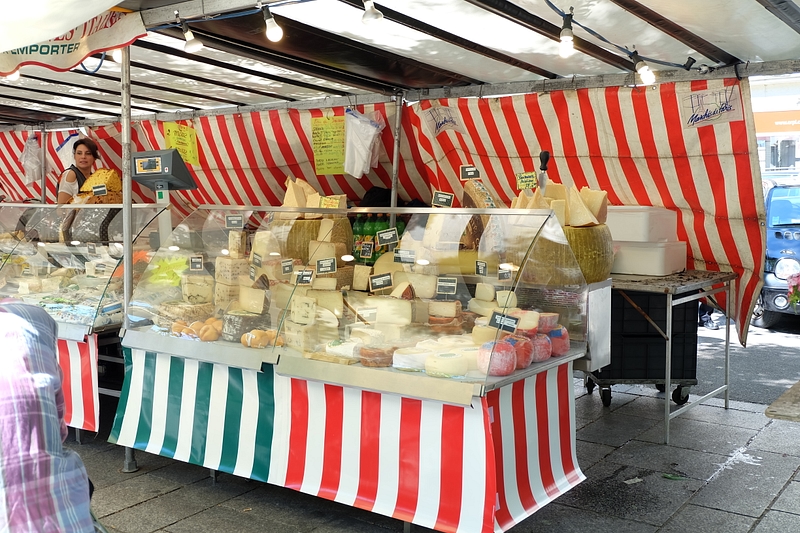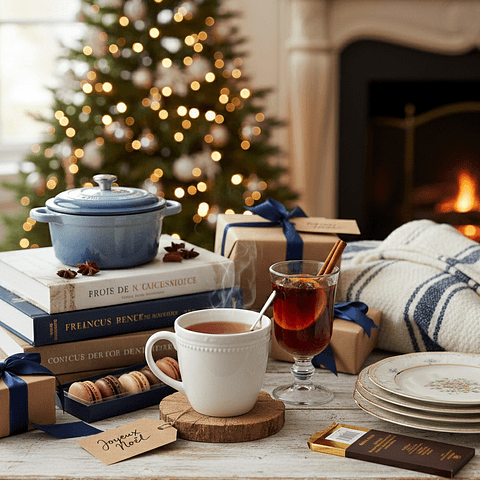
Visiting the French Market
All times of the year you will find us enjoying the Markets, but arguably summer is when they really come to life. If it is your first time visiting though, the screaming vendors and melee of people winding their way through the tiny aisles can be slightly overwhelming and sometimes down right confusing!
The good news is that with over 90 markets happening in the course of a week from 7am to around 2pm (with the exception of Mondays) here in Paris, you have your choice, and if you are considering where to go and when, this is our ‘go to’ source of information on the Market activity, a site run by the city of Paris, here !
So, now that you have figured out which Paris market you want to explore, and have chosen the day that you want to go, now what?


Once you are there ...
Know what you are getting : maraîcher vs re-seller/merchants
When talking about the markets in France, we cannot forget one of the main suppliers to the food industry here in Paris (including the Markets) : Rungis. You may be familiar with this Market, and its once famous location in the heart of Paris, Les Halles. This mega wholesale food market serves the Paris metropolitan area, and in just under 10 kilometers outside of Paris, it is a city within itself boasting that it services 18 million consumers, houses over 1200 suppliers within, and is laid out across 234 hectares (1 square mile) – it is said to be the largest in the world. So all of this to tell you that a number of the products that you find on the Markets in Paris are coming from this central location which starts buzzing with activity at 4am.
So who else might find themselves selling on the Markets in Paris? The Maraîcher, or ‘Producer’, i.e., the farming community from Ile de France that travel in to sell their products directly on the Market.
How can you tell the difference? In three words : ‘substance over form’. The maraîcher stands are certainly less likely to be well-appointed with clean, beautiful, shiny produce – they tend to look just as the people manning them. These stands are overseen by Farmers that have driven up for the morning with their produce freshly plucked from the ground, dirt and all. This also means that you are only going to have what is in season, and while there are very high quality produce, there will tend to be less variety.
Whilst we always enjoy shopping at the maraîcher, both types of suppliers have value.


Understanding the ‘etiquette'
If you haven’t already noticed, the ‘Markets’ are not just a center of commerce for a neighborhood, they are also a social center with their own set of 'règles' - rules. Welcoming a number of visitors each morning, the Market vendors also have their loyal locals, this means of course that a part of the Market experience includes a little socializing. The line may be extraordinary long; yet you see the vendor and client sharing pleasantries over (les vacances, les enfants, des nouvelles), and anything else noteworthy since their last chat. Patience is the key, and above all, remember that you are visiting their ‘boutique’.
One of the beauties of these exchanges is you will pick up on, is the vendor not just selling a product, but advising on it. In France we like to leave it to the experts: If we want a beautiful pastry, we go to a pâtisserie, if we want a nice piece of bread, we go to the boulangerie, if we want the perfect piece of fruit for our tarte, we go to the Marché. When you order a fruit (or veggie, or fromage), the vendor should be asking you what you are going to do with it and when – the peach that you want to immediately consume on the Market is very different than the one that you want to bake with during the weekend, and perhaps with the different varieties available, there will be one type more efficient for the purpose you need.
A ‘Bonjour’ and a smile go a long way to making sure that you get the best out of your time there. A little word to the wise : No matter how pretty they look, don’t squeeze the peaches! Most of the markets we frequent are NOT self-service. Only if you see bags displaced and easily accessible, can you assume that you choose your own produce (which, where is the fun in that!) – but it is always best to double check.

A typical sign at the market
Reading the Signage
Amongst the hustle and bustle of the shouting vendors and you will see on the market stands (and grocery stores for that matter) tons of signs hanging around. In France it is obligatory that the signage contain several important notes for the consumer :
The type of produce / and variety : the name of the produce
Ex above, ‘Fraise’, variety ‘Gariguette’
The category of the produce : we like labels here in France, and one of them specific to fruits and veg is the ‘catégorie’ the labels you are likely to come across are :
EXTRA (qualité supérieure) - superior, these tend to be snapped up by the fine restaurant trade
Catégorie I (bonne qualité) - great quality with minimum defaults
Catégorie II (qualité marchande) – good quality, with defaults but of course still quality
(for more on food labels in general take a look here)
EX above, Cat : 1
The origin of the produce : the country of origin must always be displayed (France, in example above)
Ex above : France
The price of the produce per unit : this can change, so be careful to keep an eagle eye as you may see prices listed per ‘piece’, ‘barquette’, or weight : usually in ‘kilos’ or ‘grams’. Keep in mind that you sometimes need to be very clear (yet polite) on exactly what you want – the ‘tranche’ of fromage that you order may be a lot bigger than you want, don’t be afraid to speak up.
Ex above : per 'barquette', with a discount if you by two!

Top tips to make sure your visit is successful :
MOST importantly : Always, always start with a ‘Bonjour’.
Don’t expect samples – if they are offered to you, it is a bonus, consider yourself lucky.
You will also tend to find cooked produce as well, great for crafting your lunch or dinner – Roast Chicken bought on the market, along with a beautiful fresh salad, bit of fromage, and a crispy baguette tend to be the typical Sunday lunch.
Bring a bag, basket, wheelie cart— something to transport your items – there are no ‘shopping’ bags on the markets and the produce you buy is likely to come in a small bag, or even just wrapped.
Eat on the Market! Depending on the month, eating oysters on the market is a ritual – you can buy them by the ‘number’ usually accompanied by a glass of wine.
Bring small bills and change.
Go early for the best pick, go late for the best prices.
Don’t assume beautiful produce is an invitation for a photo! Always ask.
Summer time you can find us doing Market Classes almost every day of the week (with the exception of Mondays as the Markets are not open on Monday!) However, attention in late July and August! These are very big vacation/holiday months in France, which also means our favorite suppliers on the markets tend to take this time off too – and while they are away, the markets just are not the same, hence why you will see we only tend to go to Marché Bastille during these times.
Be a part of the experience : The ‘post Market’ coffee is a must – particularly on Sunday when you have extra time. Shhhh – don’t tell anyone, but as ritual you will find the locals (and their shopping caddies) enjoying a beverage at le café de l'industrie just off of Marché Bastille, we also like to head over to Ten Belles Bread - and of while there, pick up some of their glorious bread!
AND if you think you want to explore with us, see what we are up here!
Enjoy your explorations!
